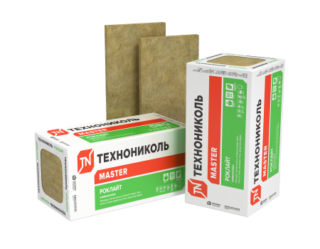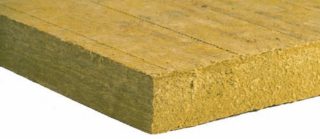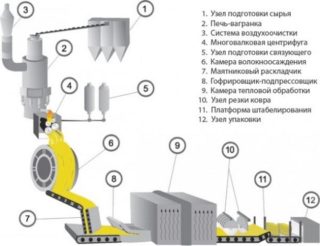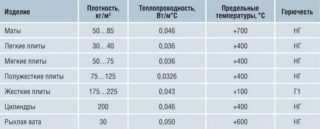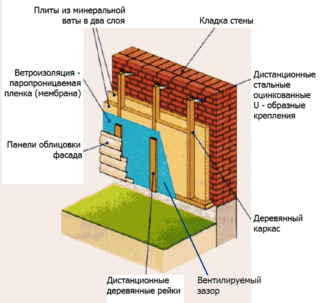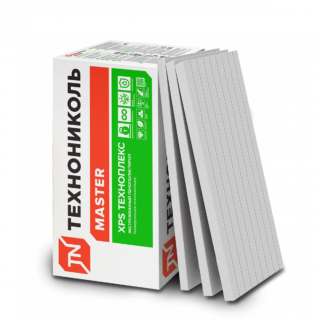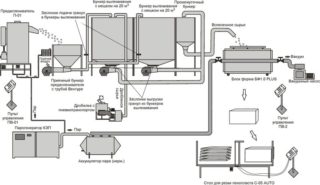In most of the territory of Russia in the autumn-spring period, temperature conditions are uncomfortable for life. The constant rise in the cost of energy makes it necessary to improve the energy efficiency of residential buildings, baths, and outbuildings. The international corporation Technonikol offers a full range of building materials for insulation and waterproofing of any buildings and structures. Based on the tasks and operating conditions, choose a basalt insulation Technonikol or extruded polystyrene.
About the manufacturer
Technonikol Corporation owns 54 plants in Russia and 6 European countries (Czech Republic, Germany, Great Britain, Belarus, Italy, Lithuania).
6 research centers are engaged in the development of testing and long-term testing of the assortment.
The quality of products meets safety requirements, which is confirmed by certificates.
Thermal insulation materials from basalt and polystyrene are popular because of their characteristics, easy installation and a range of products suitable for any operating conditions.
Basalt insulation
TechnoNIKOL mineral wool is produced in the form of rolls and plates. The production technology of the products is the same, but they have different densities. This is taken into account when designing and building, choosing the installation and finishing technology.
Appointment
The dense stone wool TechnoNIKOL in the form of plates allows exposure to mechanical stress. The main direction of use is the insulation of walls of buildings. Installation is carried out according to the technology of a wet facade (for plastering) or for facing with clapboard, tile, panels (ventilated facade).
Due to the structure of the plates, they retain heat and act as sound insulation and fire protection.
How and what is made
TechnoNIKOL mineral wool is made from basalt rock with synthetic binders and special additives that improve hydrophobic properties and prevent combustion.
In the production process, basalt goes through several stages of processing:
- The rock is cleaned of impurities and crushed to a fine fraction.
- Raw materials are subjected to melting in a high temperature furnace.
- The molten mass is mixed with additives in a centrifuge, where decomposition into individual fibers occurs simultaneously.
- The fibers are mixed with a stream of compressed air, the arrangement structure becomes chaotic.
- Cooling the resulting mass.
- Pressing on the conveyor of several layers.
- Heat treatment during which the polymerization of additives occurs.
- Cutting to the required sizes.
The whole technological process takes place without stops, so that the Minvat Technonikol becomes durable, resistant to temperature loads and other adverse factors.
Technologically, the production of plates and rolls is no different, but the finished product has a different density, therefore, different installation schemes are used when warming walls, ceilings and roofs.
When buying, check the security certificate. Counterfeit and counterfeit products often contain an unacceptable amount of phenols, and basalt itself can be radioactive.
Specifications
The corporation produces several tens of products.
When buying, pay attention to the parameters of mineral wool insulation Technonikol:
- Low thermal conductivity is achieved due to randomly arranged fibers and the air structure of the material. The parameter is in the range from 0.032 to 0.05 W / (m * K).
- Vapor permeability contributes to the fact that condensation does not accumulate in the insulation - the vapors move freely from the walls to the surrounding space, and the material does not get wet. The average rate is 0.3 mg / (m * h * Pa).
- Hydrophobicity - the ability not to absorb moisture from the surrounding air, not to get wet in damp rooms. Various types of thermal insulation of TechnoNIKOL absorb from 2 to 5% moisture from their own weight. For damp rooms choose products with a minimum rate.
- Sound insulation of the techno-nickel miniplate reduces the sound from shock loads (low frequencies up to 300 Hz), but is not very effective against street noise in the upper frequency range. The solution for noisy places is Technoflor Standard plates and Technoacoustic rolls.
- Thickness directly affects the thermal insulation properties. Plates are produced with a thickness of 50 to 200 mm, in rolls up to 70 mm.
- The length of the roll is up to 10 m with a width of up to 1.2 m, the geometric dimensions of the plates are width up to 1200 mm, height up to 1000 mm.
- Environmental friendliness complies with EU standards. The maximum content of organic substances (including phenol) in Technonikol minplits is not more than 4.5%.
- The density of materials is from 35 kg / cu. m for the Rocklight line up to 190 kg / m3 at Tekhnoruf. The parameter is important when choosing a mounting method.
- Operating temperature from -60 to 190 ° C.
Products with low density are prone to caking, so they are not used for insulation of horizontal surfaces.
Advantages and weaknesses
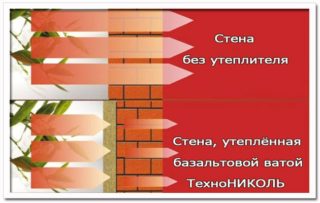 The positive and negative qualities of TechnoNIKOL thermal insulation are determined by the structure of the product and the quality of raw materials.
The positive and negative qualities of TechnoNIKOL thermal insulation are determined by the structure of the product and the quality of raw materials.
Product Advantages:
- low thermal conductivity compared to other materials;
- non-combustible material;
- environmental friendliness;
- air and vapor permeability;
- resistance to deformation;
- wide range of permissible temperatures;
- does not decay, is not damaged by rodents and insects;
- service life up to 50 years;
- relatively low cost with high rates of insulation;
- ease of installation that does not require expensive fixtures.
A significant drawback is the caking of products with low density.
To eliminate bridges of cold, special attention is paid to the processing of seams - roll models are overlapped, the seams between the plates are sealed with foam.
None of the types of insulation can be left without a decorative layer - under direct sunlight and when exposed to rain, the material gradually deteriorates.
Mounting options
 Technonikol insulation for walls is mounted in two ways, “wet” or by the principle of a ventilated facade.
Technonikol insulation for walls is mounted in two ways, “wet” or by the principle of a ventilated facade.
For the version with plastering, slabs with a density of at least 130 kg / m3 are suitable - usually they have sufficient peel strength.
Installation of a wet facade
The initial stage of “wet facade” insulation is to clean the surface of the walls of dust, dirt, oil stains, etc.
Plaster solution close the cracks in the masonry and smooth out irregularities as much as possible. Recesses of no more than 3 cm per 1 linear meter of wall are permissible.
Further, two options for mounting panels are possible: on glue or only with dowels with a wide hat (fungi). In the first, glue is applied to the wall and plate and the mixture is leveled with a notched trowel. Technonikol insulation for walls is pressed against the wall for a few seconds. For greater strength and in order not to wait for the mortar to set, the plates are reinforced with dowels of the right size. Within a day, the glue dries and proceed to further finishing.
When fastening only with dowels, a layer of vapor barrier material is laid between the wall and the insulation plates. Joints and seams are closed with foam.
The next step is to apply the first layer of plaster. For the mixture using special glue. The first layer is applied, into which the plaster mesh is recessed.
The mesh and glue should fit together - some mesh models dissolve in an alkaline environment. Reinforcing mesh is chosen for outdoor work.
Smooth the composition. After the first layer has completely dried, the main plaster is carried out. To give the surface an attractive appearance, decorative plasters are used, which are subsequently painted.
Warming with rolled materials
The first stage is cleaning and leveling the surface onto which the vapor barrier membrane is nailed.
On top of the vapor barrier beat the crate. The step of the longitudinal and transverse logs should allow a tight fit of the insulation for the facade of Technonikol. Roll material or boards are fastened with wide-bonded dowels.
Next, a layer of a windproof film is nailed to the logs with a stapler, on top of which a 1 cm thick counter-lattice is mounted. The design is needed so that there is a gap between the waterproofing and the finish coating for ventilation and evaporation of moisture from the thermal insulation.
Finishing stage - installation of finishes, which are used as ceramic tiles, plastic or wooden siding, other options.
Roof and ceiling insulation
Warming a horizontal surface is possible in two ways.
In the first case, a vapor barrier membrane is laid on the floor slabs, a layer of dense (from 150 kg / m3) mineral wool. On top of the insulation, a screed is cement-sand mortar.
The second option is fully consistent with the technology of “ventilated facade”. They install a pie: vapor barrier, insulation between the logs, a waterproofing membrane, a counter-grill, a finishing layer of OSB panels, plywood, chipboard or floorboards.
If the attic is not intended for people to be there, do not lay the final floor.
Inclined slopes of the roof should be made using the technology of a ventilated facade.
Extruded polystyrene
Extrusion polystyrene is present in the assortment of the Technonikol Corporation.
Purpose and places of use
The material is available in the form of plates and has improved thermal insulation and strength characteristics. This allows you to use it at various stages of construction.
Polystyrene foam is insulated:
- walls, floors, ceilings of buildings;
- roof and attics;
- basement and basement walls;
- blind areas.
Polystyrene is a good sound insulator and can be used in interior partitions.
Raw materials and manufacturing method
The production material is polystyrene granules, which are produced by the chemical industry from petroleum products.
In industrial lines, polystyrene is heated to the melting point and fed to the extrusion head by screw devices. Under the influence of hot steam and high pressure, the polystyrene foams, after which it is fed to the molding line, where flattening takes place.
After secondary foaming, the mass is formed on drawing machines, and after cooling, cut to the required size.
As a result of extrusion, a material is obtained consisting of many air bubbles enclosed in an individual shell. The shells are welded tightly between themselves, which makes the extrusive polystyrene waterproof and weakly absorbing moisture - all places of possible penetration are closed to it.
The company TechnoNIKOL uses carbon granules in the production of polystyrene plates, which is why the feature of the products of this manufacturer is silver color - this is one of the signs that the product is not fake.
Technical specifications
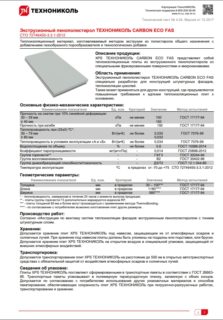 For a heater, the main parameters are thermal conductivity, ability to withstand moisture and strength.
For a heater, the main parameters are thermal conductivity, ability to withstand moisture and strength.
Parameters of extrusive polystyrene:
- thermal conductivity 0.029 - 0.031 W / (m • K);
- water absorption - 0.2% by volume;
- vapor permeability - 0.014 mg / (m • h • Pa);
- operating temperature - -70 - +70 ° C;
- thickness - from 30 to 100 mm;
- length 1180, width 580 mm.
You can carefully walk along the polystyrene laid on a horizontal surface - the dents that appear will disappear after a short period of time.
Advantages and disadvantages
The positive and negative properties of the material are directly related to its structure and technical characteristics.
The advantages of the products include low thermal conductivity, resistance to compression, incombustibility. The material does not rot and does not support the spread of fungi and mold.
The absence of cavities and moisture in the material makes it resistant to negative temperatures - foam styrene does not freeze.
The negative sides I consider low vapor and air permeability of the plates.
Low weight provides ease of installation - sheets are easy to lift to any height, and reliable brackets are not needed for fastening.
High extrusion properties of the material provide reliable adhesion to the plaster.
Polystyrene is released with grooves and with careful installation there are no cold bridges.
The disadvantages include:
- destruction from sunlight (ultraviolet radiation);
- high price;
- emission of harmful substances when heated;
- possible settlement of rodents.
The whole complex of positive and negative qualities is taken into account when choosing extruded polystyrene as thermal insulation.
Installation of polystyrene
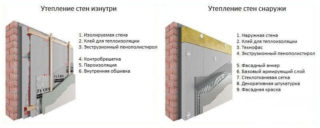 The methods of installation of polystyrene and mineral wool are not different. Work is performed in the same sequence. It is important to take measures to immediately protect the material after being installed on the wall in order to avoid destruction by sunlight.
The methods of installation of polystyrene and mineral wool are not different. Work is performed in the same sequence. It is important to take measures to immediately protect the material after being installed on the wall in order to avoid destruction by sunlight.
A feature of polystyrene is the possibility of its use for warming the underground part of buildings and the blind area around buildings.
To equip the blind areas, a clay castle, a layer of sand, polystyrene are laid in layers. The final layer is a cement-sand or concrete screed.
When warming the ceiling, it is allowed not to use a vapor barrier membrane, since the low vapor permeability of the material makes vapor barrier senseless.
The right choice and installation of insulation materials manufactured by Technonikol Corporation will save heat in the house in cold weather and keep cool in the summer. It is important to follow the installation technology so that the coating lasts for many years.
